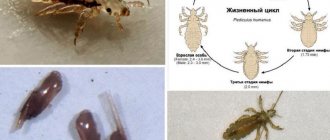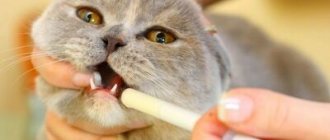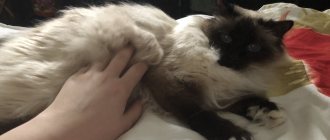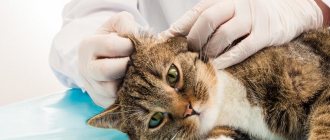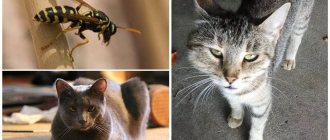Do you constantly have scratched hands, drapes on the curtains, torn sofa upholstery and scraps of wallpaper dangling? Congratulations, you are the happy owner of an active and healthy cat, or cats - whoever you like. Although some animals are taught to use scratching posts by their owners from a young age, as they say. But if you are not one of those lucky ones, then, most likely, you often wonder how to stop your furry pet from damaging your property. This is where the information from the article will come in handy.
So, how can you quickly and painlessly solve the problem? And quite simple devices made of silicone, rubber or plastic, placed on the claw of a frisky animal, will help us with this. Such attachments are popularly known as “anti-scratch” attachments. You can buy them at any pet store at a price of 230 rubles and above, it all depends on the material and the glamor of the model.
In order for the cap to hold firmly, its inner part or the surface of the claw itself is coated with a special adhesive composition, which is included in the kit. To put the device on easily, you should first lightly press the cat’s desired finger so that it releases the claw. After this, it will be possible to easily carry out the manipulation. However, let's figure out whether these protection measures are safe, and whether the information provided by the manufacturers is true. We’ll also look at reviews of nail caps for cats.
Ways to get rid of cat claws
Pet stores offer special pheromones and anti-scratch sprays. This remedy is not always effective, since the cat continues to sharpen its claws on sofas and armchairs, in addition to the carefully prepared scratching post.
A more effective, but downright cruel way to save property is onychectomy. This is an operation to remove a cat's claw with part of a finger, leading to disruption of the musculoskeletal system, pain, coordination problems, arthritis and other diseases. After it, the animal’s uniform load on the body’s muscles is disrupted, some of them experience overload, and others begin to atrophy.
The cat becomes disabled, increasingly uses its teeth and ceases to maintain hygiene in the tray due to the inability of its sore paws to turn over the litter. Often such animals end up on the street and die there.
As an alternative to surgical intervention, anti-scratchers for cats have been invented - soft claws, which are designed to stop the cutting off of cat's toes. This is a real salvation for an animal's health - an individual cover for each claw, made of multi-colored plastic, rubber or silicone.
Alternative to soft paw surgery
Onychectomy is a dangerous and cruel operation that should not be performed at the whim of the owner. Declawing a cat is like going to a clinic and having your fingers amputated. You need to approach this step with full responsibility and understand that any problem can be solved without surgical intervention.
For example, if a cat gets into the habit of sharpening its claws on furniture or walls, you can equip it with a separate place for this purpose. You can buy a scratching post or build it yourself. If your fluffy stubbornly ignores a new place for his claws, you need to try to attract him to it. Thus, purchased scratching posts usually have a special impregnation that literally attracts cats. You can do the same with homemade equipment. A few drops of valerian will solve any problems.
If a cat shows aggression towards its owners or simply scratches during active games, you can trim its claws regularly. This procedure is carried out in all veterinary clinics, beauty salons for animals, or you can trim the claws yourself. The main thing is to cut off only the sharp tip so as not to injure the animal. Also, this procedure should be carried out when the cat is calm or half asleep.
Also, silicone pads will help solve all problems with claws. Caps made of soft silicone are securely attached to the claw and protect owners and furniture from sharp cat weapons.
Whatever the owners’ decision regarding the animal’s claws, one must always remember the truism: “We are responsible for those we have tamed.” Therefore, all our actions should be aimed at the well-being of the pet and in no way harm it. And if you are involved in raising a cat from the first days, then there can be no problems with either the tray or the claws.
You can also contact our site's staff veterinarian, who will respond to them as soon as possible in the comment box below.
Help, save me, this is the situation, back in September I glued anti-scratch pads on my cat (these are silicone attachments on the claws, attached with glue), the seller said that in a month they would fall off on their own, some fell off after a week, some later, well, in general, today there are 3 attachments left (almost 5 months have passed) and today I notice that the cat is limping, I couldn’t understand what’s wrong (she doesn’t go outside), then I see these 3 attachments have grown right into the pads, and one, which apparently causes pain, has completely grown into the pad and with There’s dried blood on all sides, and there’s no way to tear them off, I can’t cut them off, I just use scissors to hurt her, she’s screaming at what to do, help, I’ll tell you right away that I’ll only be in the city at the veterinarian on Monday, how can I help the cat until then. Has anyone encountered this? How to cut it? Or is there any way to dissolve the glue?
Pour hydrogen peroxide on your cat's paw. The glue will not get wet, but you will avoid dangerous health problems. And try bandaging her paw.
Can you call the veterinarian?
Maybe you glued it somehow sloppy. And there’s such glue there, you won’t be able to tear it off. My cat didn’t last long, but yours lasted 5 months.
Author, you need to hold the paw there so that the glue dries first, so as not to glue it to your finger, but to retreat a little. Now you need to contact a veterinarian, this is a serious matter, do not leave your beloved cat crippled.
Why are anti-scratch pads needed?
The functional purpose of this invention is quite broad; claws have a huge number of advantages:
- Protects furniture from being torn apart.
- They keep the animal healthy and look aesthetically pleasing.
- Protect cat owners in case of health problems. With anti-scratch protection, the cat will no longer be able to cause a wound and cause infection.
- They will protect children and adults from a playful kitten.
- They will save your pet from showing jealousy towards another family member or animal.
- Will stop attempts to scratch or tear off stitches after surgery.
- They will provide accommodation in a clean and tidy apartment, as the cat can use the litter box without any problems.
- Bathing a pet becomes a less dangerous activity for the owner.
What are anti-scratch agents, what are they for and what is their principle of action?
Anti-scratchers for cats have another name: “soft claws”. The advent of these rubber pads made it possible to abandon the method of declawing animals. The author of the invention was Toby Wexler, an active animal advocate and veterinarian from America.
Adult cat wearing anti-scratch pads
Note! Previously, claws were removed only surgically, by completely pulling them out. After such interventions, animals experience extreme stress and can no longer defend themselves or climb trees.
Cat claw pads are a silicone or rubber pad that is glued to the nail plate using medical glue. Already in veterinary pharmacies and pet stores you can purchase the same accessories, but for dogs.
When not to use anti-scratch products
Veterinarians have mixed opinions about wearing nail guards. Firstly, putting caps on is stressful for your pet. Secondly, the opportunity to satisfy the natural need to grind off the claws is lost. Anti-scratch products are not recommended when:
- the cat walks on the street, because in case of danger, it will not be able to climb onto a hill or protect itself;
- the kitten is less than 6 months old;
- the cat, due to old age, no longer scratches either people or furniture;
- The animal has an allergic reaction to the glue.
Which animal can wear anti-scratch guards?
According to the manufacturers, anti-scratch products for cats have no age restrictions - they are suitable for both young and old. However, veterinarians advise the following:
- Do not place caps on the paws of kittens younger than 6 months. Their claws are still soft and thin, they are easily worn down during games, so they will not cause much harm to you or your property.
- For cats that walk on their own, the presence of anti-scratch protection is dangerous. An animal in natural conditions can become injured by relying too much on its modified claws.
- Due to revaluation of values, older animals themselves refuse to damage furniture or bloody games with their owners. So don't limit their freedom with incomprehensible overlays.
- The animal is easily excitable or aggressive. It can rebel against the sticking of caps by using another weapon - teeth. Therefore, it is better not to carry out the procedure yourself, but to entrust it to specialists.
Myths about claw pads
Manufacturers claim that silicone tips are completely safe for the animal, even if it swallows them. In rare cases, an allergy to the glue may occur, but it is not toxic. In Russia, there are myths about anti-scratch kits among cat owners:
- The claws itch under the caps. The assumption itself is absurd, since the claws do not have nerve endings, otherwise it would be impossible to trim or sharpen them painlessly.
- Nail guards prevent the claws from retracting. This is not true, given that the anti-scratch pads are glued to the tip sticking out of the pillow. If the cap is placed very deeply on the claw, the cat may experience discomfort, but if everything is done correctly, the pet’s movements will not be constrained.
- The gait changes. To some extent, this statement is a fact, since at first the animal gets used to the innovation and experiences stiffness in its movements. After an adaptation period, the cat begins to move confidently and calmly again.
- The glue and material used to make the attachments are toxic. Manufacturers completely refute this statement; a cat can easily chew and swallow the cap, it will come out naturally without harm to health.
Where to hide claws
In European countries, cats have long been no longer doomed to suffer, but anti-scratch treatments are used. With their help, you will protect not only children, but also furniture, wallpaper and the entire interior from the formidable weapons of your pet.
Many people are interested in the question: are anti-scratch products harmful to cats? Let's put it this way: the same as false nails for a luxurious woman. Of course not. In numerous photos and videos you can see that they are made of plastic, but quite soft. It is also biologically safe, since the possibility of ingestion by animals is taken into account. Even in this case, the cat is not in danger, since they do not irritate the esophagus.
The glue used in anti-scratch products deserves special attention. For such purposes, the same adhesive mixture is used as in medicine. Therefore, even it is as safe as possible for your beloved pet.
It should be noted that the described device is intended not only for adult cats or those who are already approaching old age, but also for small kittens. After all, anti-scratch products can be used even from the age of six months for your pet. There is no point in using them on younger animals, since they do not yet have such strong claws that can cause harm. Moreover, during the game the claws are constantly worn down on their own.
During the conversation, the question often arises that the cat will try to chew them off. Such cases are not excluded. You'll just have to re-glue the missing ones. However, the animal quickly gets used to them. This happens over several days. However, caps placed on the claws do not cause any discomfort to the cat.
Anti-scratch pads are amazing because even in them, your pet can go about its business - extend its claws and sharpen them on furniture, but at the same time it will never leave behind any traces of destruction, and its instincts will be preserved. Also, you will no longer be afraid that an animal will scratch you or your child. The moments described can be seen in the video and photos.
Based on the fact that the protective caps are glued directly to the cat’s claws, they will fall off along with them, as the scales that make up them die off. Approximately this happens one to two times a month and not at the same time. However, one bag of these anti-scratch pads is enough to replace those that have fallen off.
Thanks to their multi-colored protective caps, your cat will look glamorous and irresistible. With their help, you can create a specific manicure or glue colorless ones - for ascetics.
For your cat, try to buy protective caps only from trusted sellers.
After all, scammers can distribute counterfeits that are dangerous to your pet’s health or contain toxic glue. Before you decide to purchase the necessary product, ask how much anti-scratch products cost. The answer must exceed the amount of 350 rubles for one set, which must contain not only a set of caps, as in the photo, but also a tube of glue.
Disadvantages of anti-scratch pads
In addition to myths, you can hear unpleasant reviews about silicone caps:
- The pet's movement around the apartment becomes noisy. To solve this problem, nail guards can be glued only to the front paws.
- Slow getting used to the “manicure”. The adaptation period is individual for each animal, but if the anti-scratch pads are applied correctly, the cat should not experience discomfort for a long time.
- Rapid wear of the caps. On average, the attachments last for a month, but some cats manage to remove them much earlier. In this case, it is recommended to have spare ones.
- Nails prevent the cat from performing hygiene procedures: cleaning its ears and teeth. This concern falls entirely on the shoulders of the owner.
The role of claws in a cat's life
The claws of these pets cause their owners a lot of trouble. Wanting to rid yourself of torn wallpaper or furniture upholstery, one decision was always made - trimming the nails. More humane cat lovers purchased or ordered special corners where the cat could not only frolic, but also dig its claws into soft wood.
Modern families today solve this issue differently. They purchase anti-scratch products. The problem with claws is especially acute where small children and a cat need to get along in the same house. In the game, the baby does not understand that he is hurting the animal, and in response he may receive a blow with his paw and be seriously scratched.
Trimming nails causes significant trauma to the animal and not only physically. Claws are not only an animal's natural defense mechanism, but also a way to mark territory and maintain balance while jumping and landing on its paws. After this operation, the cat becomes quiet, stops playing - it becomes defenseless and tries to hide from the “potential danger”.
Trimming claws is equivalent to a kind of operation, after which complications are possible, and they will begin to grow back incorrectly.
There are many cases where the cochlea, which contains nerve endings and blood vessels, is affected, which can also lead to irreparable consequences.
How to use the pads
The most correct decision when putting on anti-scratch pads for the first time would be to consult a veterinarian. He will tell you about all the nuances and show how to put the caps on correctly without compromising the health of the pet and the owner.
The sizes of the nozzles are selected based on the size of the cat:
- up to 6 months, pads are contraindicated;
- XS – for kittens and cats weighing from 0.5 to 2.5 kg;
- S – animal from 2 to 4 kg;
- M – cat from 4 to 6 kg;
- L – pet from 6 kg or more.
Trying on anti-scratches is carried out immediately before gluing them. If the owner made a mistake with the size, you can trim the caps a little or buy others that are suitable in size.
The nozzle should fit tightly around the claw, not slip off, and the distance to the base of the claw is at least 3-5 mm.
Operating procedure
First of all, you need to take the cat on your lap, pet it, and let it relax. If she breaks free and runs away, in preparation for the gluing process, you need to give her the opportunity to calm down and unobtrusively massage her paws.
Steps to put on anti-scratch boots:
- without touching the parts where the blood vessel and nerve pass, you need to trim the part of the claw that bends downwards with a hook by 1 mm;
- disinfect with any antiseptic;
- Fill the cap one third with glue, so that the excess does not stick the wool together when it subsequently flows out;
- press on the pet’s paw pad so that it releases its claws, put on the pad with glue, stepping back 2 mm from the skin, hold for a few seconds for better fixation;
- hold the cat in your arms until the glue dries completely.
If the cat cannot get used to the pads or they are glued incorrectly, the caps must be removed. If the animal behaves calmly, sooner or later they will disappear on their own.
How to glue correctly: step-by-step instructions
It is better to carry out the procedure together: one holds and calms the cat, and the other sticks on the caps. Gluing consists of several stages:
- Preparing the claw. Before gluing, the tips of the claws are ground down by 1-2 mm, and the surface is gently sanded. This will allow the pads to be secured more securely.
- Fitting. First, an anti-scratch guard is put on the claw without glue. When the size is selected correctly, it fits tightly, not reaching the sinus of the claw by 2-3 mm. If the anti-scratch length is longer, then it can be cut to the required size from the socket side.
- Fill the cap 1/3 full with glue, quickly put it on the claw all the way, squeezing it lightly on the sides. Hold for 5 seconds. Before pulling the cap on, you need to lightly press on the cat's paw so that the claws extend to their full length.
- After installing the anti-scratch device, hold the cat in your hands for 10-15 minutes so that the adhesive composition polymerizes, ensuring a strong attachment of the attachments.
It is important to ensure that the glue does not get on the cat's skin. If this happens, the skin will tighten as the claw grows, causing pain to the animal. The first sign is that the pet is lethargic and avoids walking and playing.
If you have no experience with gluing, then the procedure can be carried out in several stages: after one paw is treated, give the cat a little rest from the stress it has experienced, and then work on the other.
Mr. Cat recommends: the opinion of veterinarians
Veterinarians believe that the procedure of putting on anti-scratch guards can cause stress for up to several weeks even in a calm animal. With attachments, the cat cannot fully wash itself, does not feel the surface on which it moves, all this causes discomfort. Doctors advise:
- Attach the caps only to healthy paws. If there are injuries, irritation, fungal or infectious lesions, the animal must first be treated.
- When the anti-scratch pads are already glued, you need to regularly inspect the paws for fungus or infection.
- Apply the pads carefully to prevent glue from getting on the skin, since as the claw grows, painful cracks may form on the skin, which are favorable for the development of infection.
- If an allergy to glue manifests itself in the form of irritation or swelling, you must immediately contact a veterinarian and remove the anti-scratch protectors.
Rating of claw covers and price comparison
Anti-scratch products are sold as a set of attachments of different sizes, glue and instructions for use. The cost of a set of 20 pieces averages from 230 to 400 rubles, depending on the manufacturer and the store where it is sold.
When choosing, you must take into account that low cost may be an indicator of low quality of the product. Cheap glue can cause an allergic reaction or poisoning.
You can purchase the set either in pet stores or order it on websites: aliexpress, ozone and the like.
The most popular in descending order:
| Name | Amount in a package | Colors | price, rub. |
| Anti-scratch “NEW” | 40 | 11 | 375 |
| Cliny “Soft Claws” | 40 | 6 | 285 |
| "Crazy Liberty" | 20 | 6 | 249 |
How to remove anti-scratch pads from a cat's claws
The duration of wearing stickers is on average 1.5-2 months. The pet owner does not have to remove them at all, since as the nail grows they fall off on their own. During wear, the cornea of the claw is renewed, and the cap falls off along with the old top layer. Quite often, animals chew off the pads themselves when caring for their paws.
Properly worn anti-scratch guards
Anti-scratch treatments for pets are a humane alternative to surgical declawing. This method has many advantages, the main thing is to learn how to choose the right pads and use them.
*Prices are current as of March 2020.



